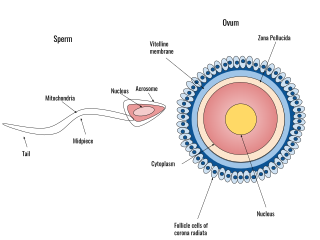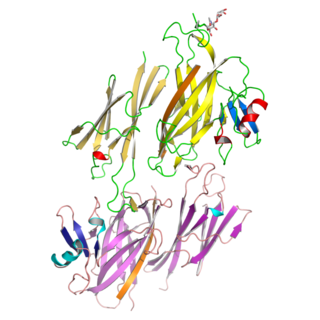Related Research Articles

During fertilization, a sperm must first fuse with the plasma membrane and then penetrate the female egg cell to fertilize it. Fusing to the egg cell usually causes little problem, whereas penetrating through the egg's hard shell or extracellular matrix can be more difficult. Therefore, sperm cells go through a process known as the acrosome reaction, which is the reaction that occurs in the acrosome of the sperm as it approaches the egg.

The zona pellucida is a specialized extracellular matrix that surrounds the plasma membrane of mammalian oocytes. It is a vital constitutive part of the oocyte. The zona pellucida first appears in unilaminar primary oocytes. It is secreted by both the oocyte and the ovarian follicles. The zona pellucida is surrounded by the corona radiata. The corona is composed of cells that care for the egg when it is emitted from the ovary.

Acrosin is a digestive enzyme that acts as a protease. In humans, acrosin is encoded by the ACR gene. Acrosin is released from the acrosome of spermatozoa as a consequence of the acrosome reaction. It aids in the penetration of the Zona Pellucida.

Human fertilization is the union of a human egg and sperm, occurring primarily in the ampulla of the fallopian tube. The result of this union leads to the production of a fertilized egg called a zygote, initiating embryonic development. Scientists discovered the dynamics of human fertilization in the nineteenth century.

The cortical reaction is a process initiated during fertilization that prevents polyspermy, the fusion of multiple sperm with one egg. In contrast to the fast block of polyspermy which immediately but temporarily blocks additional sperm from fertilizing the egg, the cortical reaction gradually establishes a permanent barrier to sperm entry and functions as the main part of the slow block of polyspermy in many animals.

The trefoil knot fold is a protein fold in which the protein backbone is twisted into a trefoil knot shape. "Shallow" knots in which the tail of the polypeptide chain only passes through a loop by a few residues are uncommon, but "deep" knots in which many residues are passed through the loop are extremely rare. Deep trefoil knots have been found in the SPOUT superfamily. including methyltransferase proteins involved in posttranscriptional RNA modification in all three domains of life, including bacterium Thermus thermophilus and proteins, in archaea and in eukaryota.

Sialyl LewisX (sLeX), also known as cluster of differentiation 15s (CD15s) or stage-specific embryonic antigen 1 (SSEA-1), is a tetrasaccharide carbohydrate which is usually attached to O-glycans on the surface of cells. It is known to play a vital role in cell-to-cell recognition processes. It is also the means by which an egg attracts sperm; first, to stick to it, then bond with it and eventually form a zygote. The discovery of the essential role that this tetrasaccharide plays in the fertilization process was reported in August 2011.

Zona pellucida sperm-binding protein 3, also known as zona pellucida glycoprotein 3 (Zp-3) or the sperm receptor, is a ZP module-containing protein that in humans is encoded by the ZP3 gene. ZP3 is the glycoprotein in the zona pellucida most important for inducting the acrosome reaction of sperm cells at the beginning of fertilization.

Zona pellucida sperm-binding protein 2 is a protein that in humans is encoded by the ZP2 gene.

Zona pellucida sperm-binding protein 4, ZP-4 or avilesine, named after its discoverer Manuel Avilés Sánchez is a protein that in humans is encoded by the ZP4 gene.

The perivitelline space is the space between the zona pellucida and the cell membrane of an oocyte or fertilized ovum. In the slow block to polyspermy, the cortical granules released from the ovum are deposited in the perivitelline space. Polysaccharides released in the granules cause the space to swell, pushing the zona pellucida farther from the oocyte. The hydrolytic enzymes released by the granules cause the zona reaction, which removes the ZP3 ligands from the zona pellucida.

Sword Stained with Royal Blood is a 2007 Chinese television series adapted from Louis Cha's novel of the same title. The series was first broadcast on CTV in Taiwan in 2007.
The Zona pellucida-like domain is a large protein region of about 260 amino acids. It has been recognised in a variety of receptor-like eukaryotic glycoproteins. All of these molecules are mosaic proteins with a large extracellular region composed of various domains, often followed by either a transmembrane region and a very short cytoplasmic region or by a GPI-anchor.

Folliculogenesis-specific basic helix-loop-helix, also known as factor in the germline alpha (FIGalpha) or transcription factor FIGa, is a protein that in humans is encoded by the FIGLA gene. The FIGLA gene is a germ cell-specific transcription factor preferentially expressed in oocytes that can be found on human chromosome 2p13.3.
Between Tears and Laughter is a 1964 Hong Kong drama film directed by Lo Chen. Set in Republic of China (1912–49) era Peking (Beiping), the story revolves around a college student and three young women: a wealthy daughter of a government bureaucrat, a traditional singer in a band and a street kung-fu/acrobat performer.

Li Ching, also spelled Lee Ching, was a Hong Kong actress.

Cortical granules are regulatory secretory organelles found within oocytes and are most associated with polyspermy prevention after the event of fertilization. Cortical granules are found among all mammals, many vertebrates, and some invertebrates. Within the oocyte, cortical granules are located along the cortex, the region furthest from the cell's center. Following fertilization, a signaling pathway induces the cortical granules to fuse with the oocyte's cell membrane and release their contents into the oocyte's extracellular matrix. This exocytosis of cortical granules is known as the cortical reaction. In mammals, the oocyte's extracellular matrix includes a surrounding layer of perivitelline space, zona pellucida, and finally cumulus cells. Experimental evidence has demonstrated that the released contents of the cortical granules modify the oocyte's extracellular matrix, particularly the zona pellucida. This alteration of the zona pellucida components is known as the zona reaction. The cortical reaction does not occur in all mammals, suggesting the likelihood of other functional purposes for cortical granules. In addition to modifying the oocyte's extracellular matrix and establishing a block to polyspermy, the exocytosis of cortical granules may also contribute towards protection and support of the developing embryo during preimplantation. Once the cortical granules complete their functions, the oocyte does not replenish them.
Rookies' Diary is a comedy television series created in Taiwan. It has a total of 43 episodes of approximately 1 hour each. It aired from July 2, 2010 to April 22, 2011. The series is about how a group of teenagers trains in the military office for 36 days. During these 36 days, they work really hard. They made new friends and had lot of fun. Even though, they still worked hard and became more mature when they left the military service of 36 days. The director of the series is Wang Wei. He is a really successful Taiwanese director around the world.
Balala the Fairies, or Balala, Little Magic Fairy, is a Chinese magical girl metaseries created and produced by Alpha Group. Each series focuses on a group of magical girls fighting against evil and dark forces while following their ordinary lives and personal wishes. The first installment was the live-action series of the same name, which first aired in 2008. There were five seasons in total and 52 episodes.
Paul Michael Wassarman is an American biologist who has been Professor in the Dept. of Cell, Developmental, and Regenerative Biology at the Icahn School of Medicine at Mount Sinai since 1996. His laboratory identified and characterised proteins that make up the zona pellucida (ZP) of mammalian eggs and determined their role in fertilisation.
References
- ↑ Huang, Hua-Lin; Lv, Chao; Zhao, Ying-Chun; Li, Wen; He, Xue-Mei; Li, Ping; Sha, Ai-Guo; Tian, Xiao; Papasian, Christopher J.; Deng, Hong-Wen; Lu, Guang-Xiu; Xiao, Hong-Mei (2014). "Mutant ZP1 in Familial Infertility". New England Journal of Medicine. 370 (13): 1220–1226. doi:10.1056/NEJMoa1308851. ISSN 0028-4793. PMC 4076492 . PMID 24670168.